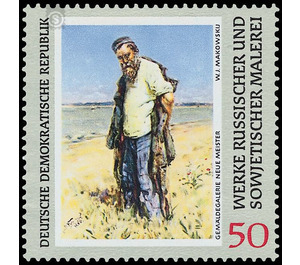Works of Russian and Soviet painters - Germany / German Democratic Republic 1969 - 50 Pfennig
Theme: Art & Culture
| Country | Germany / German Democratic Republic |
| Issue Date | 1969 |
| Face Value | 50.00 |
| Color | multi-colored grey |
| Perforation | K 13 |
| Printing Type | Photogravure |
| Stamp Type | Postage stamp |
| Item Type | Stamp |
| Chronological Issue Number | 1275 |
| Chronological Chapter | GER-DDR |
| SID | 624579 |
| In 11 Wishlists | |
Works of Russian and Soviet Painting The Ministry of Posts and Telecommunications of the German Democratic Republic publishes six multi-colored special postage stamps with illustrations of works of Russian and Soviet painting from the Gemäldegalerie "Neue Meister" in Dresden. Works of Russian and Soviet Painting in the Gemäldegalerie "Neue Meister" The 20th anniversary of the German Democratic Republic and the associated days of Soviet culture in October and November of this year provide the occasion for the publication of a series of stamps with Russian and Soviet paintings. The issue of German-Soviet friendship, which is decisive for the socialist development of our republic, is again documented by this issue, especially since the reproduced paintings are exclusively those that have found a final home in the GDR. The Dresden Gemäldegalerie is the first art museum in the world of the USSR, in which Soviet art is systematically collected and presented to visitors. With this project, the Gemäldegalerie "Neue Meister" continues to be a nursing home of the most progressive international art. The great complexes of Italian, Dutch French and Spanish art are now joined by the art of the Soviet Union and the socialist brother countries, following the general development of society. 50 Pfennig value: Vladimir Yegorovich Makovsky, b. 1846 "Man by the River" 1896 42x 26 cm, mahogany / oil In the 19th century style of bourgeois realism, Makowskij depicted the figure of a pre-revolutionary Russian worker. Although this worker is lawless and poor, the artist has expressed in his face confidence and the will to live. A comparison of this image with the steelworker of Serov makes it clear what changes have occurred in the design of the worker from the 19th to the 20th century due to the social changes.


